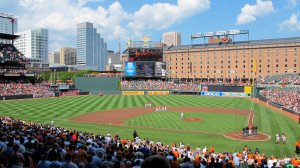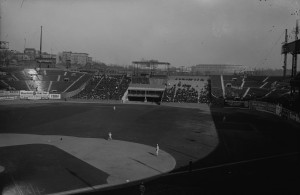
There’s an inherent joy in the lines of the most famous baseball song of all time, “Take Me Out to the Ballgame”; “I don’t care if I ever get back” hits on the essence, perhaps, of going to the game. Paul Goldberger’s new book, Ballpark: Baseball in the American City (Knopf, 362 pps, $35) shows how the experience in the actual stadia has changed over time, not merely from an amenities standpoint, but from the architectural perspective; indeed, what happens in ballpark construction is not just a reflection on baseball but of cultural and social trends in general.
There are plenty of books highlighting stadiums past and present, but Goldberger’s approach is fresh and intelligent. He identifies through lines of how and why certain types of parks went in and out of fashion, from the early days of fitting them into available nooks and crannies of cities to the suburban bowls surrounded by acres of parking to the Camden Yards-inspired “retro” feel to today, in which development around a complex with baseball less the focus seems to be taking hold.
Readers should expect to dig into Ballpark ready to think. It looks back at the earliest days of baseball in America and to some of its forgotten palaces—to wit, “The Palace of the Fans” in Cincinnati was an ornate turn-of-the-20th century structure that influenced designs in Philadelphia (Shibe Park), Boston (Fenway Park), Detroit (Navin Field, later Tiger Stadium), Brooklyn (Ebbets Field) and Chicago (Weeghman Park, later Wrigley Field, and Comiskey Park), though steel and concrete became the material of choice for those structures.

One constant in the ballpark construction world from even its earlier times is politics. Locations of stadiums became political footballs—an apt term as some of the venues ended up hosting that growing sport as well. Goldberger goes into detail on some of these battles, with the items on the pre-Bronx Bomber Yankees’ initial home, Hilltop Park, as well as its more permanent residence on River Ave. and 161 St., and the ill-fated White Sox near-debacle with New Comiskey Park (now Guaranteed Rate Field) particularly interesting.
Goldberger employs the term rus in urbe, loosely “country in the city,” to identify a main appeal of the ballpark, and the phrase fits in 2019 in the Bronx as neatly as it did in 1862 at the old Union Grounds in Brooklyn. The sense that, yes, the fan is in the city, but looking out, the expanse seems to go on infinitely. There is a wall and bleachers, but also a skyline, maybe a downtown cityscape, viewable by many within the seating—the feeling of being in the stadium but not confined by it.
It’s a powerful thought, one that the “cookie cutter” designs of the multi-purpose Riverfront, Three Rivers, Shea and Veterans Stadiums of the 60s and early 70s missed. Full wraparound bowls served neither baseball nor its increasingly influential football co-tenants, and those facilities have all been replaced by separate ones for each sport.
In the interim, the big shift to “retro” style parks, with all the modern amenities, is traced to the opening of Oriole Park at Camden Yards in Baltimore, replacing antiquated Memorial Stadium with a gem that is largely responsible for the 20+ major league parks that have opened since (only Fenway Park, Wrigley Field, Dodger Stadium, Angel Stadium, Guaranteed Rate Field, Tropicana Field and Rogers Centre predate its 1993 first pitch as current MLB venues).
As SunTrust Park in Atlanta opens its third year, Globe Life Field in Arlington, Texas, plans to open next spring, and a proposed new ballpark village—complete with a stadium and everything!—is discussed for Oakland, the fourth phase that Goldberg discusses is in full swing. It’s worth this deep look back into how we got here.
 IBO Boxing Honesty and Integrity
IBO Boxing Honesty and Integrity